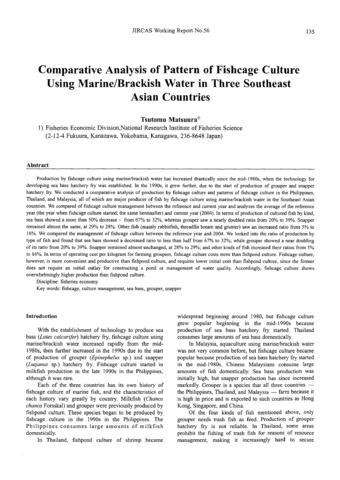Common carp in floating net cage culture
Share
นามธรรม
The main objective of this experiment was to determine the optimal density or stocking rate for the optimal total production and growth rate of common carp, Cyprinus carpio . A raft of 10 x 10 m made of steel bars with drums as floaters was divided into nine plots. A cage of polyethylene 3 x 3 x 2 m, 1 inch mesh size was hung in every plot. About three fourths of the cage was under water. Three stages of stocking rate of common carp of about 130 g individual weight were used: 2 kg/m2, 4 kg/m2 and 6 kg/m2. The experimental Latin Square design was used. Artificial fish food (pellet) containing about 32 percent crude protein was given five times a day. Fish were fed to satiation. Morphometrical and limnological data were measured every 14 days. Individual growth and actual rations were calculated daily. As a result of this experiment, common carp culture is floating net cages with a stocking rate of 6 kg/m2 is recommended.
การอ้างอิง
Jangkaru, Z., & Djajadiredja, R. (1979). Common carp in floating net cage culture. In Proceedings of the International Workshop on Pen Cage Culture of Fish, 11-22 February 1979, Tigbauan, Iloilo, Philippines (pp. 55-60). Tigbauan, Iloilo, Philippines: Aquaculture Department, Southeast Asian Fisheries Development Center.
เรื่อง
รายการที่เกี่ยวข้อง
แสดงรายการที่เกี่ยวข้องตามชื่อผู้แต่งผู้สร้างและเรื่อง
-
The culture of tilapia
Aldon, Eva T. (Aquaculture Department, Southeast Asian Fisheries Development Center, 1998) -
Recent developments in aquaculture in Japan
Fukusho, K. (Aquaculture Department, Southeast Asian Fisheries Development Center, 1995)Aquaculture production in Japan in 1993 was 1,351,000 tons, 15.6% of the total fisheries production. About 93.6% came from mariculture and 6.4% from freshwater aquaculture. The per cent contribution of aquaculture to total ... -
Comparative analysis of pattern of fishcage culture using marine/brackish water in three Southeast Asian countries
Matsuura, Tsutomu (Japan International Research Center for Agricultural Sciences, 2007)Production by fishcage culture using marine/brackish water has increased drastically since the mid-1980s, when the technology for developing sea bass hatchery fry was established. In the 1990s, it grew further, due to the ...





